Abstract
apo E has been shown to modulate cholesterol balance in arterial wall cells. Production of apo E by macrophages in atherosclerotic plaques could thereby influence the development of the plaque lesion. Cytokines, including TNF alpha, have been identified in human lesions, therefore, we undertook a series of studies to evaluate the effect of TNF alpha on monocyte/macrophage apo E production. The addition of TNF alpha to freshly isolated human monocytes led to a four- to fivefold increase of apo E mRNA abundance. The addition of TNF alpha to fully differentiated macrophages either had no effect or modestly inhibited apo E mRNA expression. THP1 human monocytic cells also responded to TNF alpha in a phenotype-specific manner. Treatment of these cells with TNF alpha produced a dose- and time-dependent increase in apo E mRNA. This increase was reflected in apo E synthesis and was associated with inhibition of DNA synthesis, and with induction of c-fos and ICAM-1 gene expression. Cell-permanent analogues of ceramide did not reproduce TNF alpha effect on apo E, but antagonists of protein kinase C did inhibit its effect. TNF alpha induction of apo E mRNA abundance was associated with stimulation of apo E promoter-dependent gene transcription. In summary, TNF alpha stimulates apo E gene transcription, mRNA abundance, and protein synthesis in the monocyte/macrophage in a phenotype-specific manner. Such regulation could significantly modify the amount of apo E present in vessel wall lesions.
Full text
PDF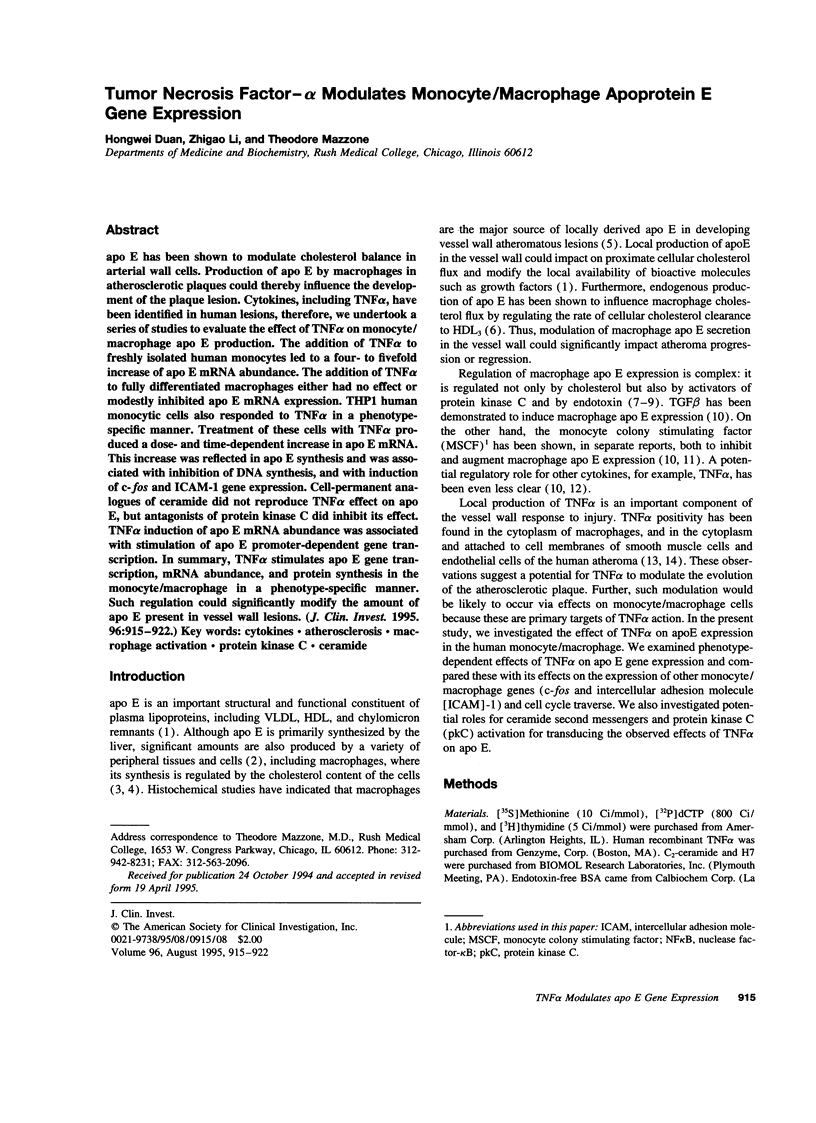

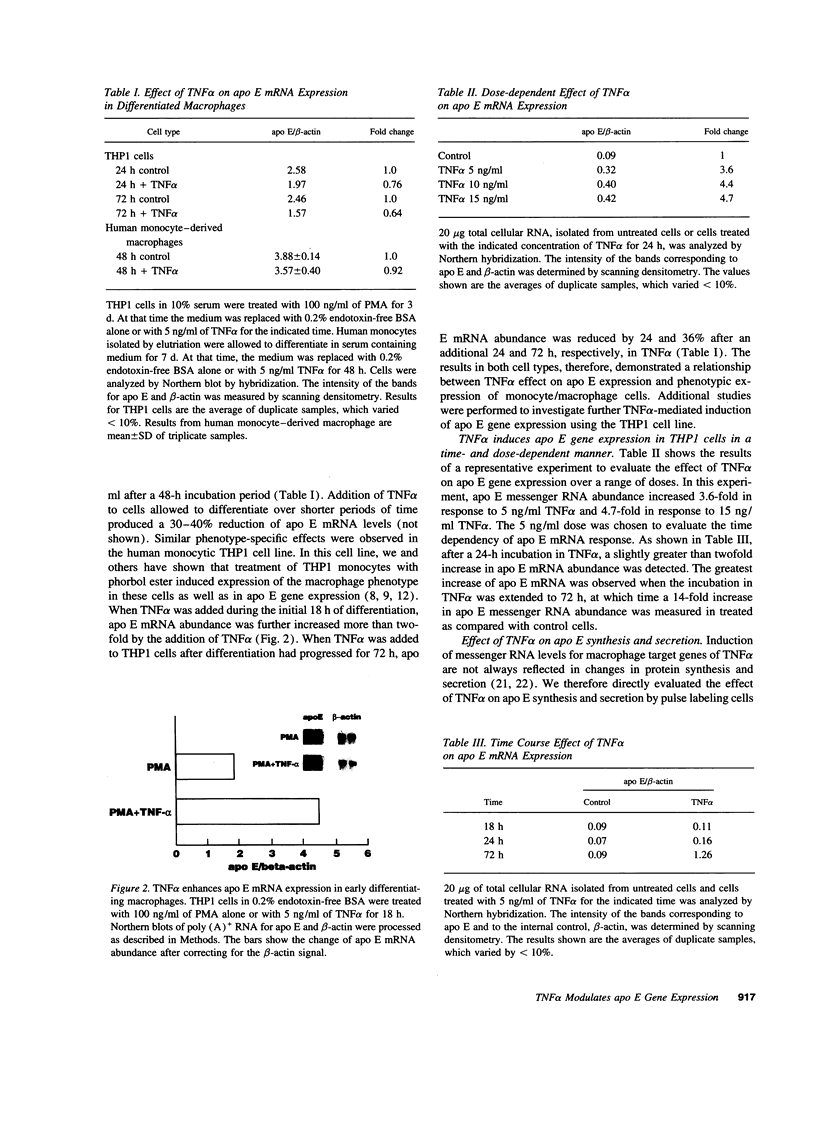
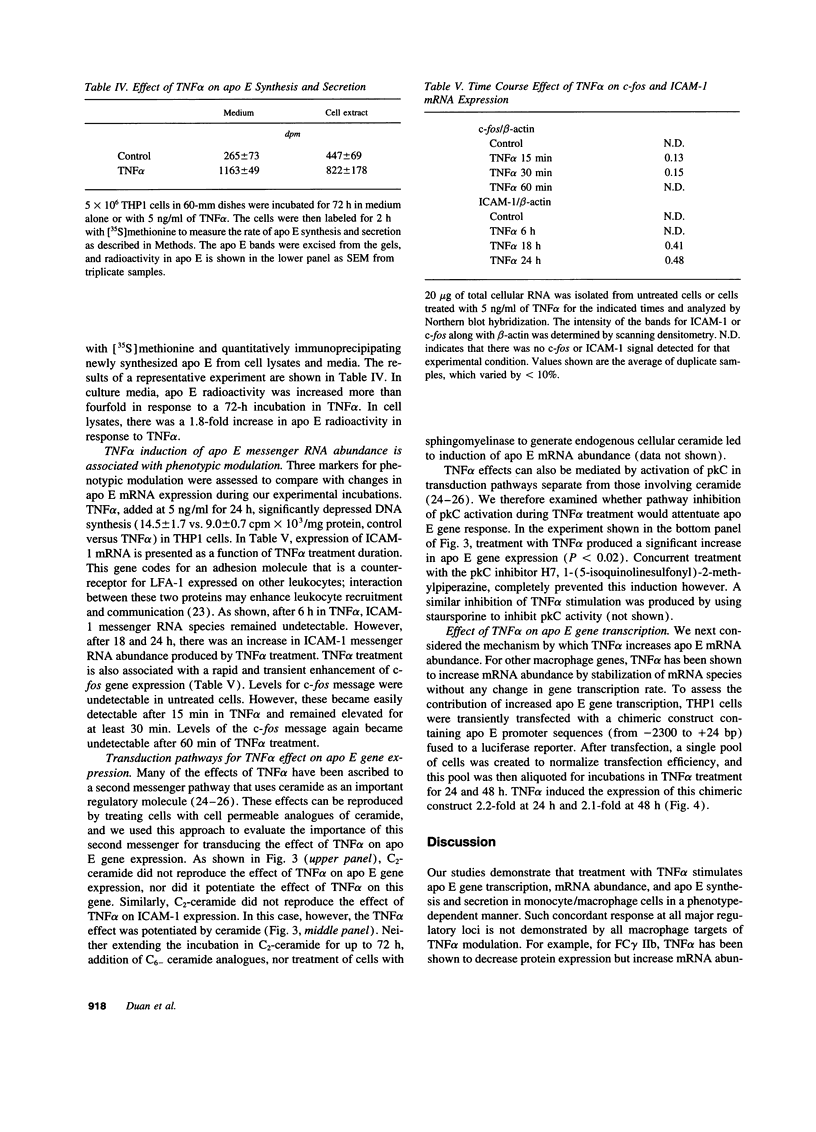

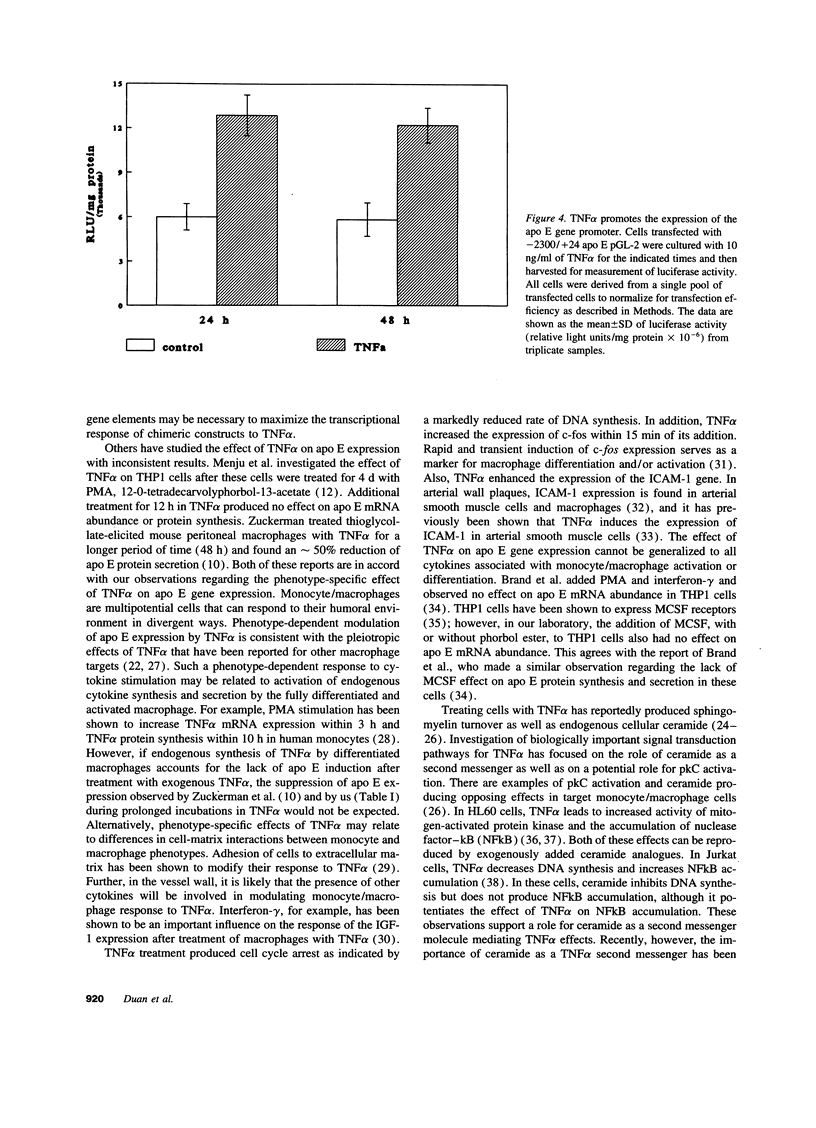

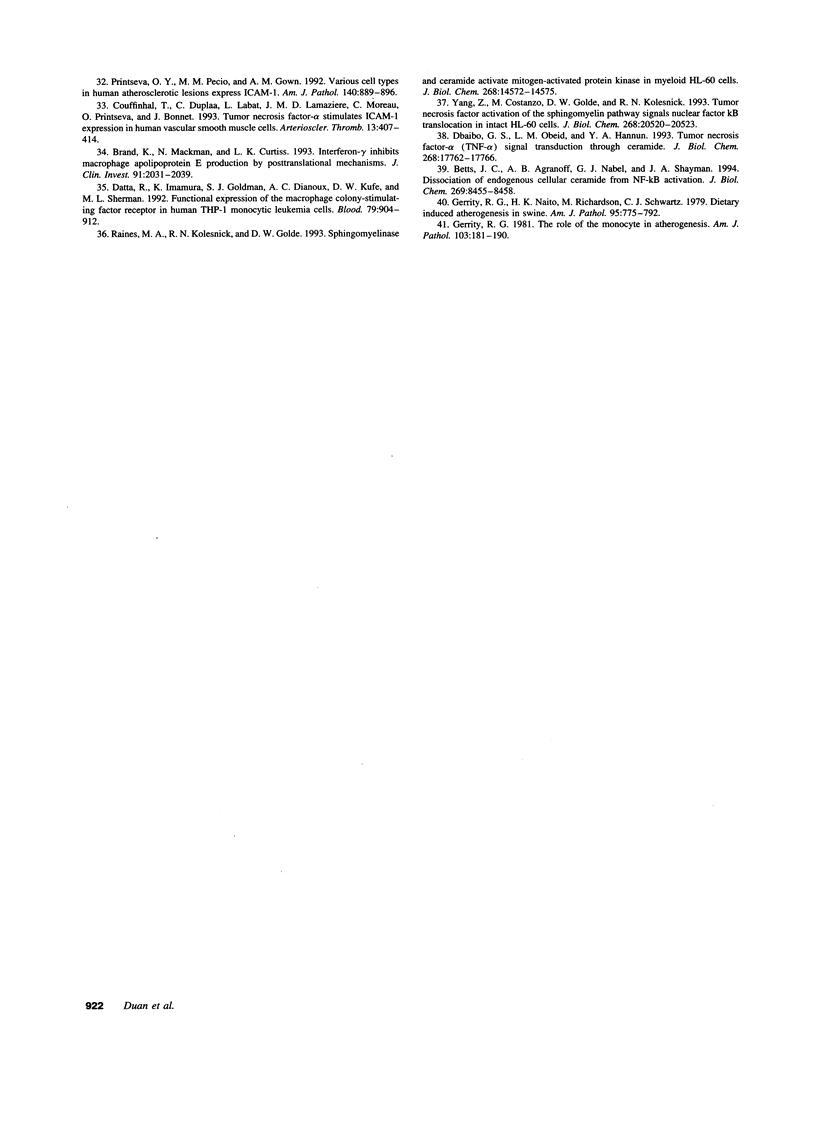
Images in this article
Selected References
These references are in PubMed. This may not be the complete list of references from this article.
- Auwerx J. H., Deeb S., Brunzell J. D., Peng R., Chait A. Transcriptional activation of the lipoprotein lipase and apolipoprotein E genes accompanies differentiation in some human macrophage-like cell lines. Biochemistry. 1988 Apr 19;27(8):2651–2655. doi: 10.1021/bi00408a003. [DOI] [PubMed] [Google Scholar]
- Barath P., Fishbein M. C., Cao J., Berenson J., Helfant R. H., Forrester J. S. Detection and localization of tumor necrosis factor in human atheroma. Am J Cardiol. 1990 Feb 1;65(5):297–302. doi: 10.1016/0002-9149(90)90291-8. [DOI] [PubMed] [Google Scholar]
- Basheeruddin K., Rechtoris C., Mazzone T. Evaluation of the role of Ap1-like proteins in the enhanced apolipoprotein E gene transcription accompanying phorbol ester induced macrophage differentiation. Biochim Biophys Acta. 1994 Jun 21;1218(2):235–241. doi: 10.1016/0167-4781(94)90021-3. [DOI] [PubMed] [Google Scholar]
- Basheeruddin K., Rechtoris C., Mazzone T. Transcriptional and post-transcriptional control of apolipoprotein E gene expression in differentiating human monocytes. J Biol Chem. 1992 Jan 15;267(2):1219–1224. [PubMed] [Google Scholar]
- Basu S. K., Brown M. S., Ho Y. K., Havel R. J., Goldstein J. L. Mouse macrophages synthesize and secrete a protein resembling apolipoprotein E. Proc Natl Acad Sci U S A. 1981 Dec;78(12):7545–7549. doi: 10.1073/pnas.78.12.7545. [DOI] [PMC free article] [PubMed] [Google Scholar]
- Betts J. C., Agranoff A. B., Nabel G. J., Shayman J. A. Dissociation of endogenous cellular ceramide from NF-kappa B activation. J Biol Chem. 1994 Mar 18;269(11):8455–8458. [PubMed] [Google Scholar]
- Brand K., Mackman N., Curtiss L. K. Interferon-gamma inhibits macrophage apolipoprotein E production by posttranslational mechanisms. J Clin Invest. 1993 May;91(5):2031–2039. doi: 10.1172/JCI116425. [DOI] [PMC free article] [PubMed] [Google Scholar]
- Chait A., Mazzone T. A secretory product of human monocyte-derived macrophages stimulates low density lipoprotein receptor activity in arterial smooth muscle cells and skin fibroblasts. Arteriosclerosis. 1982 Mar-Apr;2(2):134–141. doi: 10.1161/01.atv.2.2.134. [DOI] [PubMed] [Google Scholar]
- Chicheportiche Y., Vassalli P. Tumor necrosis factor induces a block in the cotranslation of Fc gamma RIIb mRNA in mouse peritoneal macrophages. J Biol Chem. 1994 Aug 5;269(31):20134–20138. [PubMed] [Google Scholar]
- Clinton S. K., Underwood R., Hayes L., Sherman M. L., Kufe D. W., Libby P. Macrophage colony-stimulating factor gene expression in vascular cells and in experimental and human atherosclerosis. Am J Pathol. 1992 Feb;140(2):301–316. [PMC free article] [PubMed] [Google Scholar]
- Couffinhal T., Duplàa C., Labat L., Lamaziere J. M., Moreau C., Printseva O., Bonnet J. Tumor necrosis factor-alpha stimulates ICAM-1 expression in human vascular smooth muscle cells. Arterioscler Thromb. 1993 Mar;13(3):407–414. doi: 10.1161/01.atv.13.3.407. [DOI] [PubMed] [Google Scholar]
- Datta R., Imamura K., Goldman S. J., Dianoux A. C., Kufe D. W., Sherman M. L. Functional expression of the macrophage colony-stimulating factor receptor in human THP-1 monocytic leukemia cells. Blood. 1992 Feb 15;79(4):904–912. [PubMed] [Google Scholar]
- Dbaibo G. S., Obeid L. M., Hannun Y. A. Tumor necrosis factor-alpha (TNF-alpha) signal transduction through ceramide. Dissociation of growth inhibitory effects of TNF-alpha from activation of nuclear factor-kappa B. J Biol Chem. 1993 Aug 25;268(24):17762–17766. [PubMed] [Google Scholar]
- Gerrity R. G., Naito H. K., Richardson M., Schwartz C. J. Dietary induced atherogenesis in swine. Morphology of the intima in prelesion stages. Am J Pathol. 1979 Jun;95(3):775–792. [PMC free article] [PubMed] [Google Scholar]
- Gerrity R. G. The role of the monocyte in atherogenesis: I. Transition of blood-borne monocytes into foam cells in fatty lesions. Am J Pathol. 1981 May;103(2):181–190. [PMC free article] [PubMed] [Google Scholar]
- Hannun Y. A. The sphingomyelin cycle and the second messenger function of ceramide. J Biol Chem. 1994 Feb 4;269(5):3125–3128. [PubMed] [Google Scholar]
- Heller R. A., Krönke M. Tumor necrosis factor receptor-mediated signaling pathways. J Cell Biol. 1994 Jul;126(1):5–9. doi: 10.1083/jcb.126.1.5. [DOI] [PMC free article] [PubMed] [Google Scholar]
- Kolesnick R., Golde D. W. The sphingomyelin pathway in tumor necrosis factor and interleukin-1 signaling. Cell. 1994 May 6;77(3):325–328. doi: 10.1016/0092-8674(94)90147-3. [DOI] [PubMed] [Google Scholar]
- LOWRY O. H., ROSEBROUGH N. J., FARR A. L., RANDALL R. J. Protein measurement with the Folin phenol reagent. J Biol Chem. 1951 Nov;193(1):265–275. [PubMed] [Google Scholar]
- Lake F. R., Noble P. W., Henson P. M., Riches D. W. Functional switching of macrophage responses to tumor necrosis factor-alpha (TNF alpha) by interferons. Implications for the pleiotropic activities of TNF alpha. J Clin Invest. 1994 Apr;93(4):1661–1669. doi: 10.1172/JCI117148. [DOI] [PMC free article] [PubMed] [Google Scholar]
- Libby P., Hansson G. K. Involvement of the immune system in human atherogenesis: current knowledge and unanswered questions. Lab Invest. 1991 Jan;64(1):5–15. [PubMed] [Google Scholar]
- Mahley R. W. Apolipoprotein E: cholesterol transport protein with expanding role in cell biology. Science. 1988 Apr 29;240(4852):622–630. doi: 10.1126/science.3283935. [DOI] [PubMed] [Google Scholar]
- Mazzone T., Basheeruddin K. Dissociated regulation of macrophage LDL receptor and apolipoprotein E gene expression by sterol. J Lipid Res. 1991 Mar;32(3):507–514. [PubMed] [Google Scholar]
- Mazzone T., Gump H., Diller P., Getz G. S. Macrophage free cholesterol content regulates apolipoprotein E synthesis. J Biol Chem. 1987 Aug 25;262(24):11657–11662. [PubMed] [Google Scholar]
- Mazzone T., Pustelnikas L., Reardon C. A. Post-translational regulation of macrophage apoprotein E production. J Biol Chem. 1992 Jan 15;267(2):1081–1087. [PubMed] [Google Scholar]
- Mazzone T., Reardon C. Expression of heterologous human apolipoprotein E by J774 macrophages enhances cholesterol efflux to HDL3. J Lipid Res. 1994 Aug;35(8):1345–1353. [PubMed] [Google Scholar]
- Menju M., Tajima S., Yamamoto A. Expression of the apolipoprotein E gene in a human macrophage-like cell line, THP-1. J Biochem. 1989 Sep;106(3):505–510. doi: 10.1093/oxfordjournals.jbchem.a122882. [DOI] [PubMed] [Google Scholar]
- Müller R. Cellular and viral fos genes: structure, regulation of expression and biological properties of their encoded products. Biochim Biophys Acta. 1986;823(3):207–225. doi: 10.1016/0304-419x(86)90003-x. [DOI] [PubMed] [Google Scholar]
- Nathan C., Sporn M. Cytokines in context. J Cell Biol. 1991 Jun;113(5):981–986. doi: 10.1083/jcb.113.5.981. [DOI] [PMC free article] [PubMed] [Google Scholar]
- Newman T. C., Dawson P. A., Rudel L. L., Williams D. L. Quantitation of apolipoprotein E mRNA in the liver and peripheral tissues of nonhuman primates. J Biol Chem. 1985 Feb 25;260(4):2452–2457. [PubMed] [Google Scholar]
- Printseva OYu, Peclo M. M., Gown A. M. Various cell types in human atherosclerotic lesions express ICAM-1. Further immunocytochemical and immunochemical studies employing monoclonal antibody 10F3. Am J Pathol. 1992 Apr;140(4):889–896. [PMC free article] [PubMed] [Google Scholar]
- Raines M. A., Kolesnick R. N., Golde D. W. Sphingomyelinase and ceramide activate mitogen-activated protein kinase in myeloid HL-60 cells. J Biol Chem. 1993 Jul 15;268(20):14572–14575. [PubMed] [Google Scholar]
- Rosenfeld M. E., Butler S., Ord V. A., Lipton B. A., Dyer C. A., Curtiss L. K., Palinski W., Witztum J. L. Abundant expression of apoprotein E by macrophages in human and rabbit atherosclerotic lesions. Arterioscler Thromb. 1993 Sep;13(9):1382–1389. doi: 10.1161/01.atv.13.9.1382. [DOI] [PubMed] [Google Scholar]
- Sariban E., Imamura K., Luebbers R., Kufe D. Transcriptional and posttranscriptional regulation of tumor necrosis factor gene expression in human monocytes. J Clin Invest. 1988 May;81(5):1506–1510. doi: 10.1172/JCI113482. [DOI] [PMC free article] [PubMed] [Google Scholar]
- Shieh J. H., Peterson R. H., Warren D. J., Moore M. A. Modulation of colony-stimulating factor-1 receptors on macrophages by tumor necrosis factor. J Immunol. 1989 Oct 15;143(8):2534–2539. [PubMed] [Google Scholar]
- Springer T. A. Adhesion receptors of the immune system. Nature. 1990 Aug 2;346(6283):425–434. doi: 10.1038/346425a0. [DOI] [PubMed] [Google Scholar]
- Werb Z., Chin J. R. Endotoxin suppresses expression of apoprotein E by mouse macrophages in vivo and in culture. A biochemical and genetic study. J Biol Chem. 1983 Sep 10;258(17):10642–10648. [PubMed] [Google Scholar]
- Witsell A. L., Schook L. B. Tumor necrosis factor alpha is an autocrine growth regulator during macrophage differentiation. Proc Natl Acad Sci U S A. 1992 May 15;89(10):4754–4758. doi: 10.1073/pnas.89.10.4754. [DOI] [PMC free article] [PubMed] [Google Scholar]
- Yang Z., Costanzo M., Golde D. W., Kolesnick R. N. Tumor necrosis factor activation of the sphingomyelin pathway signals nuclear factor kappa B translocation in intact HL-60 cells. J Biol Chem. 1993 Sep 25;268(27):20520–20523. [PubMed] [Google Scholar]
- Zhang Y., Doerfler M., Lee T. C., Guillemin B., Rom W. N. Mechanisms of stimulation of interleukin-1 beta and tumor necrosis factor-alpha by Mycobacterium tuberculosis components. J Clin Invest. 1993 May;91(5):2076–2083. doi: 10.1172/JCI116430. [DOI] [PMC free article] [PubMed] [Google Scholar]
- Zuckerman S. H., Evans G. F., O'Neal L. Cytokine regulation of macrophage apo E secretion: opposing effects of GM-CSF and TGF-beta. Atherosclerosis. 1992 Oct;96(2-3):203–214. doi: 10.1016/0021-9150(92)90066-p. [DOI] [PubMed] [Google Scholar]




